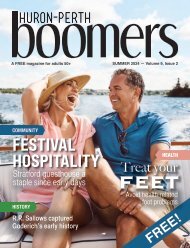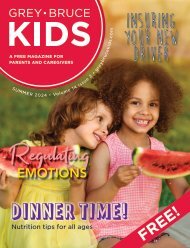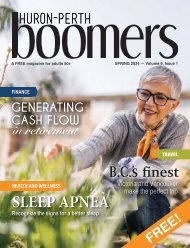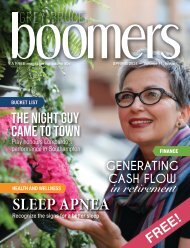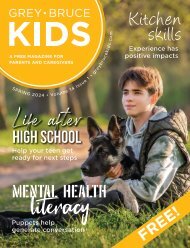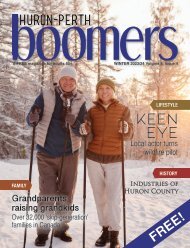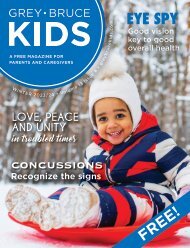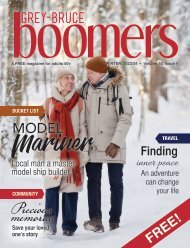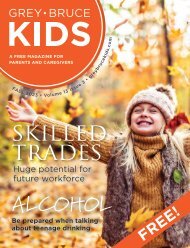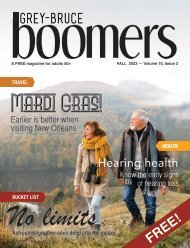Grey-Bruce Kids Spring 2021
A FREE magazine for parents and caregivers
A FREE magazine for parents and caregivers
You also want an ePaper? Increase the reach of your titles
YUMPU automatically turns print PDFs into web optimized ePapers that Google loves.
EDUCATION<br />
Hands-on history<br />
in digital times<br />
BY MIKE SCHWINDT<br />
consider myself very lucky to be living in the era in which we<br />
I live.<br />
As an Education/Outreach Coordinator at the <strong>Bruce</strong> County<br />
Museum & Cultural Centre, I work every day surrounded by<br />
artifacts of days past. I will never complain about the effort<br />
involved in laundry again since seeing what passed as state-ofthe-art<br />
in the early-1900s!<br />
Even better, at our Museum, I can physically touch things.<br />
Unlike many points in human history, we live in an era where<br />
children can be children and learn by picking things up,<br />
manipulating them, and trying to figure out what they can do<br />
with them.<br />
Some of my earliest memories come from the cusp of this time,<br />
with my Great Aunt Ruth taking me to the London Children’s<br />
Museum. Aunt Ruth, coming from an earlier generation, was<br />
decidedly uncomfortable with the idea of touching museum<br />
exhibits or items. I, as a child who wanted to behave, had to<br />
be convinced by a staff member to do so! My two most vivid<br />
memories are of touching a plasma ball so that all my hair stood<br />
on end, and digging – like a real paleontologist – for dinosaur<br />
bones. Imagine my joy, when I started at the Museum, to<br />
discover that I could dig for fossils at work!<br />
Unfortunately, thanks to COVID-19, we’ve come full circle. The<br />
teachers I know and work with have gone from classrooms full<br />
of objects to use and learn from in a hands-on way, with groups<br />
of students sharing and interacting in an engaging environment,<br />
to sterile, separate desks with very few hands-on materials,<br />
knowing that after each use, they will need to sit untouched for<br />
days or be sanitized to be safe.<br />
To bring some joy back to the classroom, the Museum has<br />
launched a Digital Education Centre where educators and<br />
parents can experience our programming resources. Classes can<br />
virtually participate in our Day in the Life of a Pioneer Child<br />
program, take part in Ancient Civilizations activities, learn about<br />
the Last Frontier, and so much more.<br />
As we all started online learning this past January, I was working<br />
from home on new resources and digital programs for the<br />
Museum to share with schools and the community. At the<br />
same time, all kinds of interesting things were happening in the<br />
background – my youngest child was doing yoga in the middle<br />
of the living room floor so she could see the computer screen,<br />
while my oldest was cutting slices of carrots for her counters and<br />
running into issues with them disappearing or putting dog treats<br />
on top of the tablet so she could “share” her dog.<br />
Despite (and sometimes because of) this, I was able to write and<br />
create and develop. As much of a challenge as it was balancing<br />
support for my kids’ learning and work, it happened, and with<br />
some really interesting results.<br />
Working on an activity to deliver an educational program based<br />
on our new digital exhibit, Earth’s Climate in the Balance, I was<br />
14 GREY-BRUCE KIDS • SPRING <strong>2021</strong> greybrucekids.com • 15







